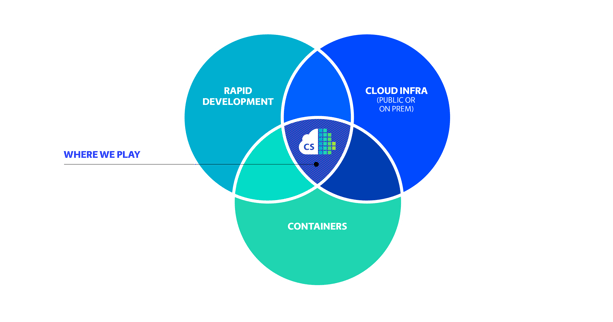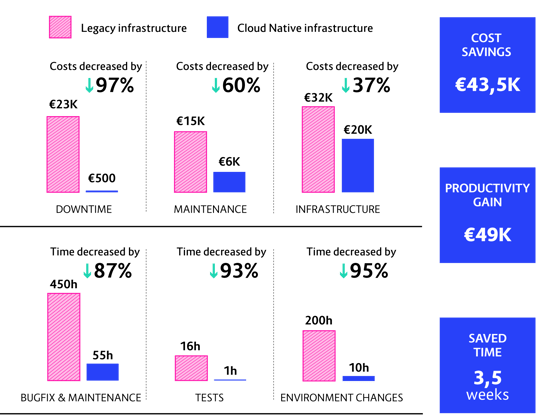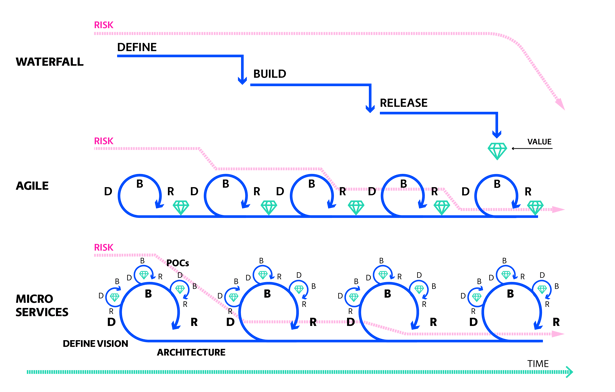‘Container Solutions’ may, depending on your perspective, may be a misnomer. If you peel back the lid on our company, you see that we work at the intersection of containers, cloud infrastructure and rapid development. Why here? What is the relationship between these three things? And importantly, where do our customers come into this picture? These are the questions I will try and answer in this blog.
Image 1 - Where Container Solutions play.
Anne, in her new book, makes a compelling observation. Even though the companies she studied value machine productivity, they value developer productivity even more. In practice, this means that companies are pretty happy with the lower costs they can realise with cloud infrastructure. They are pretty happy about changing capital expenditure into operational expenditure in a pay as you go model. They are also pretty happy that tools like the DC/OS and Kubernetes can be used to automate many operations tasks. Companies are, however, ecstatic at how short their time-to-value has become, how easily deploys can be rolled forward or backward and their managers, if they are being truthful, are delighted to have a lot fewer headaches, which is especially true once the migration to Cloud Native has complete - the transformation itself does of course create it’s own set of headaches.
A Story In Numbers That Doesn’t Actually Tell The Story
About a year ago, we helped a customer with some dramatic changes to their infrastructure. We migrated them from a serviced AWS offering to a set up on Google’s Container Engine. In doing so, we were able to realise some interesting savings. For example, the time spent on environmental changes dropped from 200 hours per month to 10. The test cycle, partially due to the parallelisation of their execution, dropped from 16 hours to 1 hour. This meant that the company could react to new customer insights and hypotheses quickly. For web companies, this speed represents significant competitive advantage.
For this particular team, the savings accumulated to over half a million euros per year. But the funny thing is, the cost savings are really only a small part of the value that was created. If you ask our customers after a project is completed, what is the thing you value most? They won’t mention the costs savings and certainly not mention their virtual machine utilisation (which is always far better after the Container Solutions’ engineers have set the cloud up). Instead, they will answer that they value how quickly and effortlessly they can deliver. I.e. that they value rapid development.
Image 2 - Lots of cost savings for our customers but they mainly care about rapid development and friction free operations.
Cloud Native Computing and Risk
Rapid development is associated with risk. Less risk lets you move fast without breaking things. With the waterfall model, you had to tolerate a lot of risk right until the end of the project. This risk included requirements risk - are we building the right thing? - infrastructure risk - will it work on the target infrastructure as planned? - and design risks - will it scale?
With iterative and incremental software methods, it was possible to realise value in steps and in doing so reduce risks in steps. However, in practice, it was not possible to get access to production-like infrastructure until close to the end of projects. This meant that although the iterative methods reduced the risks associated with user requirements they did not reduce all the infrastructure risks.
With Cloud Native development, it’s possible to take a lot of infrastructure risk out of the project straight away. With the infrastructure made almost invisible, microservice teams can iterate quickly, often in hourly cycles, so that value is created and “wrong feature” risk is decreased in a continuous fashion. In practice, this means that developers are free to program against a cluster as if it were a laptop. In other words, developers, free from worry about the underlying infrastructure, are able to move quickly. It is this quick movement that is enabled by containers and cloud infrastructure and which is so highly valued by our customers.
Image 3 - A popular model created by Pini and Svitlana that shows how well managed cloud projects reduce risk constantly through the project.
Conclusion
At Container Solutions we have observed that, more than anything, our customers value rapid development. They care less about containers and cloud infrastructure, even though, via reduced risks, these two technologies enable rapid development. We, on the other hand, care very much about containers and the cloud since these are how we create competitive advantage for our customers.
If you’d like to read about this in more depth and find out how SkyScanner, ASOS and the FT succeeded with Cloud Native, download a free copy of Anne’s book now using the link below.





 Previous article
Previous article
